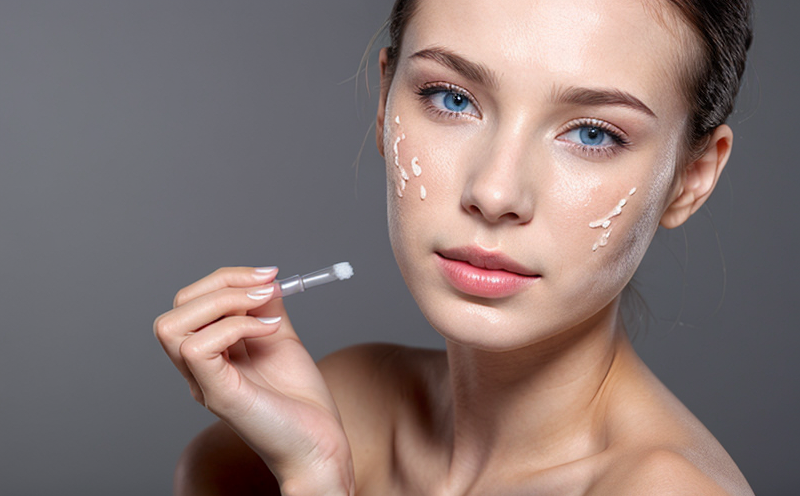Volunteer Patch Testing for Skin Care Products
Volunteer patch testing is a critical component in ensuring the safety and efficacy of cosmetic products before they reach the market. This testing method involves applying test substances to volunteers' skin to observe any adverse reactions or irritations. It plays an essential role in complying with regulatory requirements, protecting consumers, and maintaining brand integrity. The primary objective is to identify potential allergens, sensitizers, or irritants that could cause harm if not properly managed.
The process typically involves selecting a panel of volunteers who are representative of the target demographic for the product. These individuals undergo detailed medical evaluations before participating in the testing. Once selected, they apply the test substances to their skin according to specified protocols. The patches remain on the skin for predetermined durations, after which the volunteers document any visible or reported adverse effects.
Regulatory standards such as ISO 10993-11 provide guidance on how to conduct patch testing effectively. Compliance with these standards ensures that the results are reliable and can be trusted by regulatory bodies worldwide.
The test parameters for volunteer patch testing include:
- Type of Test Substance: The substances tested can range from new ingredients to existing products reformulated for specific markets. They must be selected based on their potential risk to consumers.
- Patch Duration: The patches remain in place for periods ranging from 24 hours up to seven days, depending on the product and regulatory requirements.
- Observation Period: After removal of the patches, volunteers are observed over a specified time frame to monitor for any delayed reactions or effects that may not be immediately visible.
- Data Collection: Volunteers record observations in real-time. This includes noting the onset and nature of any irritation, redness, swelling, or other adverse effects.
The specimen preparation involves meticulous attention to detail. The patches are carefully applied according to standardized protocols, ensuring that each volunteer receives consistent treatment. Post-test data is meticulously recorded and analyzed by our experienced team of scientists to ensure accuracy and reliability.
Our state-of-the-art laboratory facilities support this rigorous testing process with advanced instrumentation and analytical techniques. This ensures that we can provide comprehensive results that meet the highest regulatory standards.
Why It Matters
The importance of volunteer patch testing cannot be overstated, especially in the context of cosmetic products. Regulatory authorities around the world mandate rigorous safety assessments to protect consumers from potential harm. Patch testing helps identify allergens and sensitizers early in the development process, allowing manufacturers to address these issues before product launch.
Failure to comply with these regulations can result in legal repercussions, damage to brand reputation, and loss of consumer trust. By conducting thorough volunteer patch tests, companies demonstrate their commitment to quality and safety, which is crucial for maintaining a positive image and fostering customer loyalty.
The testing process also helps manufacturers make informed decisions about product formulation. Insights gained from these tests can guide the development of safer and more effective products, ultimately leading to improved consumer satisfaction and enhanced brand reputation.
Benefits
Volunteer patch testing offers numerous benefits that extend beyond regulatory compliance:
- Safety Assurance: Ensures that products are safe for use by the general public, reducing the risk of adverse reactions.
- Regulatory Compliance: Adheres to international standards and regulations, ensuring a smooth product launch process.
- Informed Decision-Making: Provides valuable data for refining product formulations and improving overall quality.
- Consumer Trust: Builds confidence in the brand by demonstrating a commitment to consumer safety and well-being.
- Competitive Advantage: Differentiates companies that prioritize safety, potentially attracting more customers and enhancing market share.
- Risk Management: Identifies potential risks early, minimizing costly recalls and legal challenges.
The comprehensive nature of patch testing ensures that products are safe for a wide range of skin types, including those with sensitivities or allergies. This broadens the product’s marketability and appeal.
Customer Impact and Satisfaction
Conducting thorough volunteer patch tests has a direct impact on customer satisfaction and brand loyalty. Consumers today are increasingly concerned about the safety of the products they use, and companies that prioritize safety can build strong relationships with their customers.
By offering safe and effective cosmetic products, manufacturers can enhance their reputation as responsible and ethical businesses. This positive image attracts new customers and retains existing ones, leading to increased customer satisfaction and loyalty.
The data gathered from patch testing is invaluable in addressing consumer concerns and expectations. Companies that engage in such rigorous testing demonstrate a commitment to quality, which resonates with consumers who value safety and transparency. This can lead to higher customer retention rates and positive word-of-mouth reviews.





